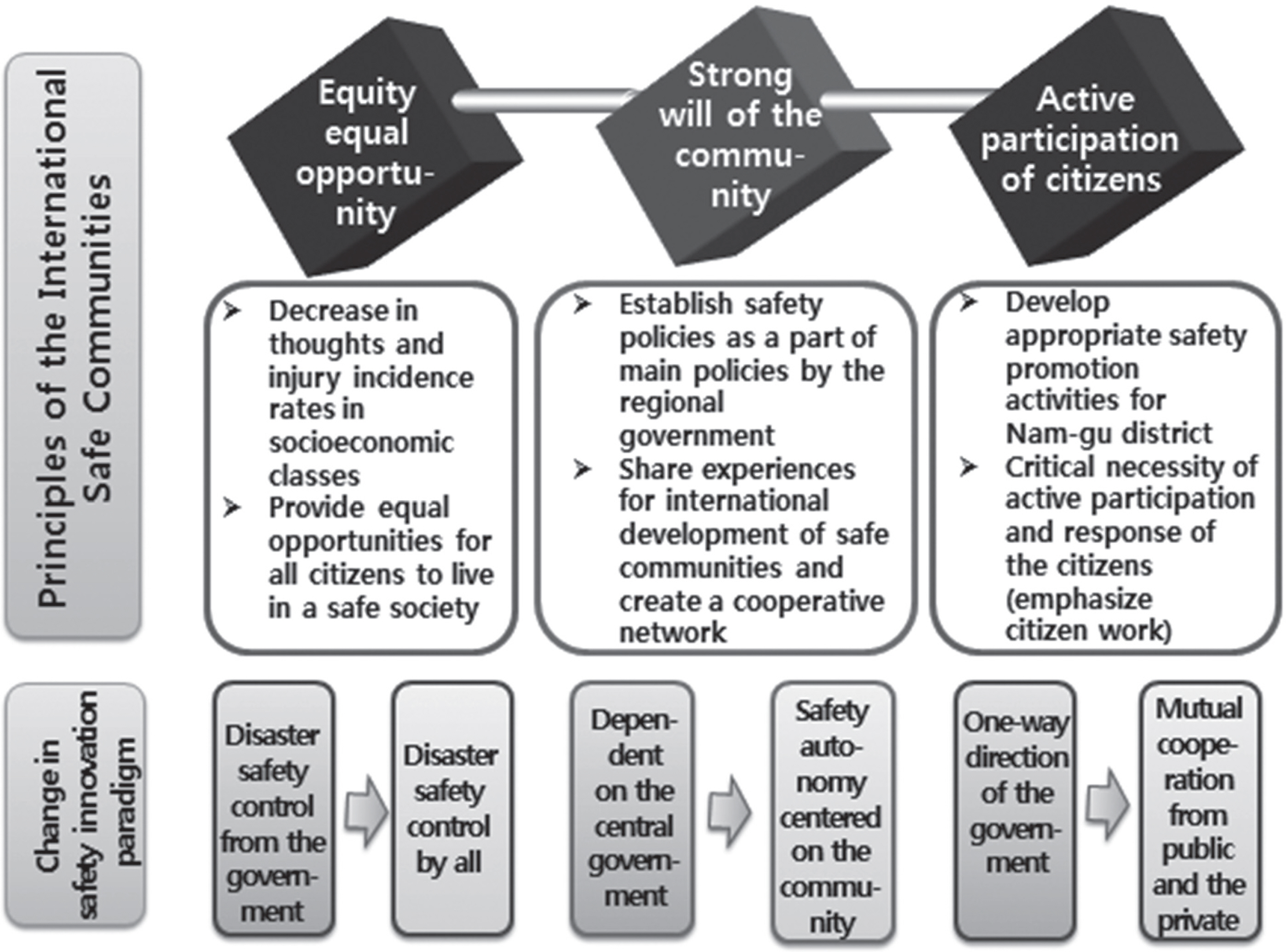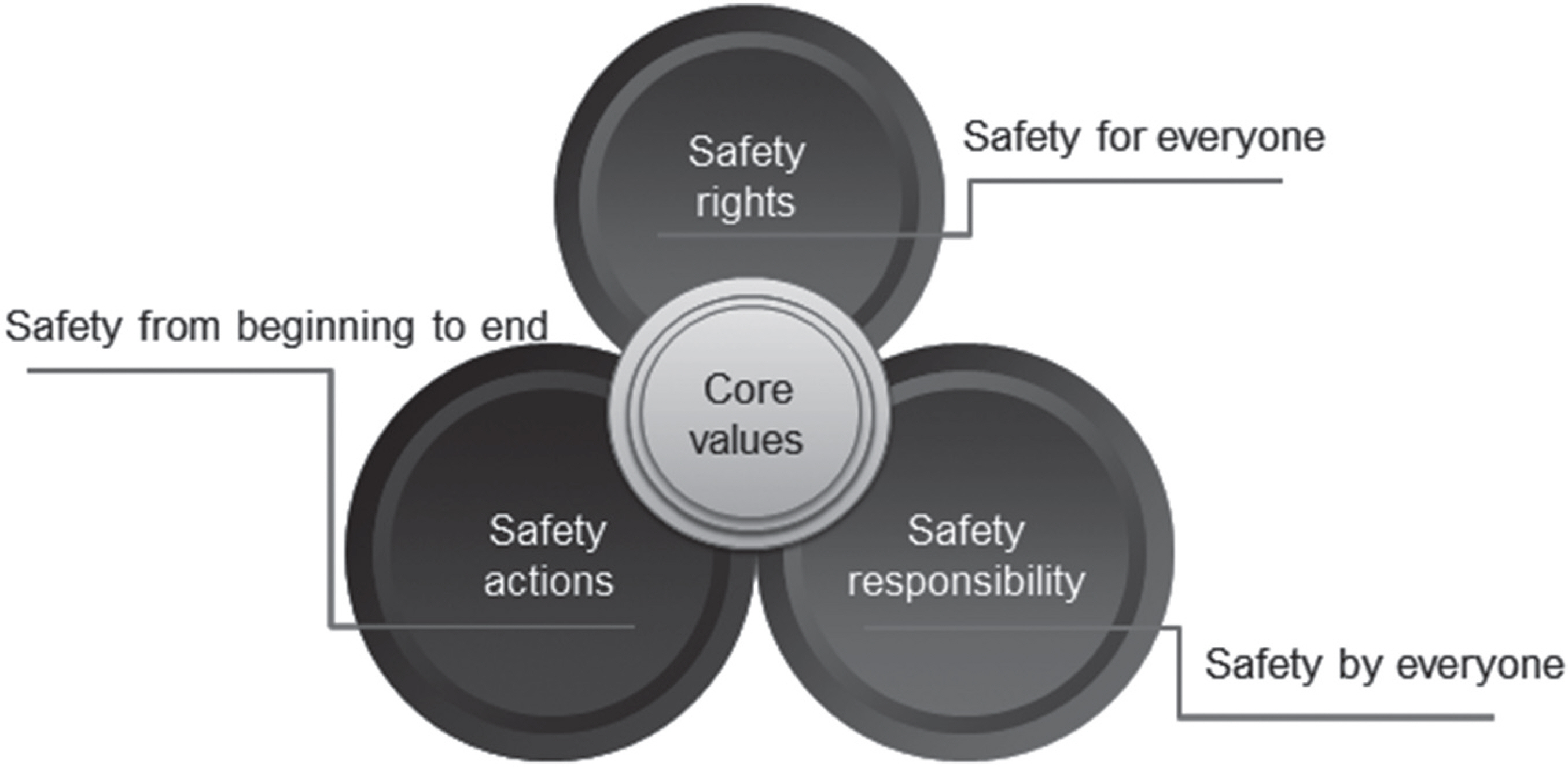Articles
- Page Path
- HOME > J Korean Acad Nurs > Volume 45(6); 2015 > Article
-
Original Article
- Application and Developmental Strategies for Community-Based Injury Prevention Programs of the International Safe Communities Movement in Korea
- Jeongyee Bae1, Joonpil Cho2, Seong-il Cho3, Minyeong Kwak4, Taehyen Lee5, Christina Aram Bae6
-
Journal of Korean Academy of Nursing 2015;45(6):910-918.
DOI: https://doi.org/10.4040/jkan.2015.45.6.910
Published online: December 15, 2015
1Department of Nursing, Inje University, Busan
2Department of Emergency Medicine, Medical School, Aju University, Suwon
3Department of Rehabilitation Science, Graduate School, Inje University, Busan
4Department of Nursing, Graduate School, Inje University, Busan
5Department of Molecular Biology, Busan National University, Busan
6Department of English Language and Literature, Seoul National University, Seoul, Korea
1Department of Nursing, Inje University, Busan
2Department of Emergency Medicine, Medical School, Aju University, Suwon
3Department of Rehabilitation Science, Graduate School, Inje University, Busan
4Department of Nursing, Graduate School, Inje University, Busan
5Department of Molecular Biology, Busan National University, Busan
6Department of English Language and Literature, Seoul National University, Seoul, Korea
- Address reprint requests to : Bae, Jeongyee Department of Nursing, Inje University, 75 Bokji-ro, Busanjin-gu, Busan 47392, Korea Tel: +82-51-890-6823 Fax: +82-51-896-9840 E-mail: jibai@inje.ac.kr
Copyright © 2015 Korean Society of Nursing Science
This is an Open Access article distributed under the terms of the Creative Commons Attribution NoDerivs License. (http://creativecommons.org/licenses/by-nd/4.0) If the original work is properly cited and retained without any modification or reproduction, it can be used and re-distributed in any format and medium.
Abstract
-
Purpose
- Safety of humans is an important factor that affects health overall, and injuries are one of the major public-health problems in the world. The purposes of this study were to describe the International safe Community movement which contributes to the injury prevention and safety promotion all over the world, and to identify out the application and developmental strategies for Korea.
-
Methods
- A review was done of previous research, reviews, and reports on the history, concepts, basic principles, and recommendations for actions of the Safe Community.
-
Results
- For this study, the application strategies of the International Safe Community movement in Korea were examined to deduce the strengths of the safe Community program. Community-based injury prevention work according to the International Safe Community model is a successful and cost-effective way of reducing injuries in the community.
-
Conclusion
- Through the International Safe Community program, communities are able to realize a healthy community and achieve improved quality of lives for the people, which is the ultimate objective of the Safe Community model. In addition, it will contribute to the economic vitalization and gain through energy and enhancement of productivity of people.

- 1. Svanström L, Haglund BJA. Evidence-based safety promotion and injury prevention-an introduction [Internet]. Stockholm, SE: Karolinska Institutet; 2000.[cited 2015 October 12]. Available from:. http://www.ki.se/csp/pdf/Books/EvidenceBasedSkadepre-vEngvers.pdf
- 2. Jansson B. Festschrift in honour a safe community-a tribute to Leif Svanström. International Journal of Injury Control and Safety Promotion. 2012;19(3):189–191. http://dx.doi.org/10.1080/17457300.2012.709724ArticlePubMed
- 3. Kendrick D, Young B, Mason-Jones AJ, Ilyas N, Achana FA, Cooper NJ, et al. Home safety education and provision of safety equipment for injury prevention (Review). Evidence-Based Child Health. 2013;8(3):761–939. http://dx.doi.org/10.1002/ebch.1911ArticlePubMed
- 4. World Health Organization. Human factors in patient safety review of topics and tools [Internet]. Geneva, CH: Author; 2009.[cited 2015 October 12]. Available from:. http://www.who.int/patient-safety/research/methods_measures/human_factors/human_factors_review.pdf
- 5. Welander G, Svanström L, Ekman R. Safety promotion-an introduction. 2nd ed. Stockholm, SE: Karolinska Institutet; 2004.
- 6. World Health Organization Collaborating Centre on Community Safety Promotion. How do we define a safe community? [Internet]. Stockholm, SE: Karolinska Institutet; 2004.[cited 2009 August 16]. Available from:. http://www.phs.ki.se/csp/who_intro-duction_en.htm
- 7. Mitchell R, Haddrill K. WHO safe communities-should we expand the definition of a ‘community’? International Journal of Injury Control and Safety Promotion. 2007;14(1):60–63. http://dx.doi.org/10.1080/17457300600775585ArticlePubMed
- 8. Nilsen P, Bourne M, Coggan C. Using local injury surveillance for community-based injury prevention: An analysis of Scandinavian WHO safe community and Canadian safe community foundation programmes. International Journal of Injury Control and Safety Promotion. 2007;14(1):35–43. http://dx.doi.org/10.1080/17457300600864447ArticlePubMed
- 9. Jansson B. Research on the prevention of fall injuries still makes prediction for practice difficult. Age and Ageing. 2007;36(3):351–352. http://dx.doi.org/10.1093/ageing/afm027Article
- 10. McClure RJ. Injury risk and prevention in context. Injury Prevention. 2010;16(6):361–362. http://dx.doi.org/10.1136/ip.2010.028175ArticlePubMed
- 11. Seedat M, McClure R, Suffla S, van Niekerk A. Developing the evidence-base for safe communities: A multi-level, partly randomised, controlled trial. International Journal of Injury Control and Safety Promotion. 2012;19(3):231–241. http://dx.doi.org/10.1080/17457300.2012.705303ArticlePubMed
- 12. World Health Organization. The Adelaide recommendations: Healthy public policy. Health Promotion International. 1988;3(2):183–186. http://dx.doi.org/10.1093/heapro/3.2.183Article
- 13. World Health Organization. Ottawa charter for health promotion. Health Promotion International. 1986;1(4):405http://dx.doi.org/10.1093/heapro/1.4.405-aArticle
- 14. World Health Organization Collaborating Centre on Community Safety Promotion. Manifesto for safe communities. Paper presented at The First World Conference on Accident and Injury Prevention. 1989.September 17-20; Stockholm, Sweden.
- 15. Svanström L. Evidence-based injury prevention and safety promotion: Some results. A chapter in the Report: Evidence-based injury prevention and safety promotion and Slutrapporten: Samh llets oly-cksbarn. F rslag till nationella j mlikhetsstrategier –lera skadefria r f r alla. Stockholm, SE: Sweden’s National Institute of Public Health; 1998.
- 16. Butterfoss FD. Process evaluation for community participation. Annual Review of Public Health. 2006;27:323–340. http://dx.doi.org/10.1146/annurev.publhealth.27.021405.102207ArticlePubMed
- 17. Svanström L. It all started in Falk ping, Sweden: Safe Communities-global thinking and local action for safety. International Journal of Injury Control and Safety Promotion. 2012;19(3):202–208. http://dx.doi.org/10.1080/17457300.2012.696661ArticlePubMed
- 18. Ekman R, Ekman DS, Schyllander J, Schelp L. A comparison of unintentional injury patterns occurring in two Swedish communities in 1978 and in 2008. International Journal of Injury Control and Safety Promotion. 2015;22(3):254–259. http://dx.doi.org/10.1080/17457300.2014.918153ArticlePubMed
- 19. Rahim Y. Safe community in different settings. International Journal of Injury Control and Safety Promotion. 2005;12(2):105–112. http://dx.doi.org/10.1080/17457300500089954ArticlePubMed
- 20. Lindqvist K. Motala municipality-a sustainable safe community in Sweden. International Journal of Injury Control and Safety Promotion. 2012;19(3):249–259. http://dx.doi.org/10.1080/17457300.2012.692692ArticlePubMed
REFERENCES
Figure & Data
REFERENCES
Citations

- Classifying strategies for building community health movements: a guide for implementers
Felicia Jia Hui Chan, Alyssa Yenyi Chan, Wen Xi Zhuang, Priyanka Rajendram, Joseph Jie Hui Quek, Weng Mooi Tan, Yoek Ling Yong, Clarice Liying Song, Zoe Jane-Lara Hildon
BMC Public Health.2025;[Epub] CrossRef - THE SAFE COMMUNITY CONCEPT – A SUCCESSFUL TOOL FOR INJURY PREVENTION AND SAFETY PROMOTION
Birutė Strukčinskienė, Sabine Distl, Sigitas Griškonis
Visuomenės sveikata.2019; 28(7): 41. CrossRef - Iranian Designated Safe Communities: A Quantitative Analysis
Jafar Sadegh Tabrizi, Homayoun Sadeghi Bazargani, Reza Mohammadi, Mohammad Saadati
Trauma Monthly.2017;[Epub] CrossRef


Figure 1.
Figure 2.
| Safety innovation master plan from the ministry of public safety and security |
International safe communities designation indicator | |
|---|---|---|
| Strategies | Tasks | |
| Strategy 1: | Strengthen the ability of the control tower for on-site support | Indicator 1: An infrastructure based on partnership and collaborations, governed by a cross-sectional group that is responsible for safety promotion in their community |
| Strengthen the ability of the control tower | ||
| Establish a disaster response standardized system applicable for all disasters | Indicator 2: Long-term, sustainable programs covering both genders, all ages, environments and situations | |
| Build an improvement system for general management of safety policies of each sector | ||
| Set a standard and direction for safety policies | ||
| Strategy 2: | Strengthen ability and sense of responsibility for disaster response of the community | Indicator 1: An infrastructure based on partnership and collaborations, governed by a cross-sectional group that is responsible for safety promotion in their community |
| Ability strengthening for on-site response | ||
| Strengthen training and education of disaster prevention | ||
| Strengthen rescue and response ability on land and sea | ||
| Strategy 3: | Strengthen National Safety Education based on life-cycle | Indicator 2: Long-term, sustainable programs covering |
| Expansion of safety | both genders, all ages, environments and situations | |
| culture in daily life | Increase omnidirectional pan-national safety culture | Indicator 5: Programs that document the frequency and |
| causes of injuries | ||
| Create a public-private partnership governance with | Indicator 1: An infrastructure based on partnership and | |
| community involvement | collaborations, governed by a cross-sectional group that | |
| is responsible for safety promotion in their community | ||
| Strengthen safety welfare policies | Indicator 3: Programs that target high-risk groups and | |
| environments, and programs that promote safety for | ||
| vulnerable groups | ||
| Strategy 4: | Research and evaluation of disaster, strengthen reflux system | Indicator 6: Evaluation measures to assess their programs, |
| Expansion of | processes and the effects of change | |
| infrastructure for disaster safety prevention | Secure continuity of safety tasks through prevention Realization of scientific and effective disaster prevention | Indicator 4: Programs that are based on all available evidence |
| Promote safety industry through new growth power | ||
| Strategy 5: | Sectors including school, energy, traffic, disaster, industrial | Indicator 2: Long-term, sustainable programs covering |
| Creative safety control | complex and harmful chemical substances | both genders, all ages, environments and situations |
| by sectors | ||
 KSNS
KSNS
 E-SUBMISSION
E-SUBMISSION

 Cite
Cite

